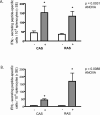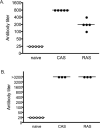Chemically attenuated Plasmodium sporozoites induce specific immune responses, sterile immunity and cross-protection against heterologous challenge
- PMID: 18672017
- PMCID: PMC2560175
- DOI: 10.1016/j.vaccine.2008.07.017
Chemically attenuated Plasmodium sporozoites induce specific immune responses, sterile immunity and cross-protection against heterologous challenge
Abstract
Vaccination with Plasmodium sporozoites attenuated by irradiation or genetic manipulation induces a protective immune response in rodent malaria models. Recently, vaccination with chemically attenuated P. berghei sporozoites (CAS) has also been shown to elicit sterile immunity in mice. Here we show that vaccination with CAS of P. yoelii also protects against homologous infection and that a P. berghei CAS vaccine cross protects against heterologous challenge with P. yoelii sporozoites. Vaccination with P. yoelii or P. berghei CAS induced parasite-specific antibodies and IFN-gamma-producing CD8(+) T cells at levels not significantly different from radiation-attenuated sporozoites. Our findings provide an initial characterization of the immune response generated by CAS vaccination and suggest that this attenuation process could be used in the production of an effective cross-protective liver stage vaccine for malaria.
Figures



Similar articles
-
Cross-protection between attenuated Plasmodium berghei and P. yoelii sporozoites.Parasite Immunol. 2007 Nov;29(11):559-65. doi: 10.1111/j.1365-3024.2007.00976.x. Parasite Immunol. 2007. PMID: 17944745 Free PMC article.
-
Differential effector pathways regulate memory CD8 T cell immunity against Plasmodium berghei versus P. yoelii sporozoites.J Immunol. 2010 Mar 1;184(5):2528-38. doi: 10.4049/jimmunol.0903529. Epub 2010 Jan 22. J Immunol. 2010. PMID: 20097864 Free PMC article.
-
Class II-restricted protective immunity induced by malaria sporozoites.Infect Immun. 2008 Mar;76(3):1200-6. doi: 10.1128/IAI.00566-07. Epub 2007 Dec 26. Infect Immun. 2008. PMID: 18160479 Free PMC article.
-
Host-parasite interactions and immunity to irradiated sporozoites.Immunol Lett. 1990 Aug;25(1-3):39-42. doi: 10.1016/0165-2478(90)90088-8. Immunol Lett. 1990. PMID: 2283161 Review.
-
The role of intrahepatic lymphocytes in mediating protective immunity induced by attenuated Plasmodium berghei sporozoites.Immunol Rev. 2000 Apr;174:123-34. doi: 10.1034/j.1600-0528.2002.00013h.x. Immunol Rev. 2000. PMID: 10807512 Review.
Cited by
-
Strain-specific immunity induced by immunization with pre-erythrocytic stages of Plasmodium chabaudi.Parasite Immunol. 2011 Jan;33(1):73-8. doi: 10.1111/j.1365-3024.2010.01251.x. Parasite Immunol. 2011. PMID: 21189655 Free PMC article.
-
Why functional pre-erythrocytic and bloodstage malaria vaccines fail: a meta-analysis of fully protective immunizations and novel immunological model.PLoS One. 2010 May 19;5(5):e10685. doi: 10.1371/journal.pone.0010685. PLoS One. 2010. PMID: 20502667 Free PMC article.
-
Protection from experimental cerebral malaria with a single dose of radiation-attenuated, blood-stage Plasmodium berghei parasites.PLoS One. 2011;6(9):e24398. doi: 10.1371/journal.pone.0024398. Epub 2011 Sep 15. PLoS One. 2011. PMID: 21935405 Free PMC article.
-
Our impasse in developing a malaria vaccine.Cell Mol Life Sci. 2011 Apr;68(7):1105-13. doi: 10.1007/s00018-011-0634-5. Epub 2011 Feb 15. Cell Mol Life Sci. 2011. PMID: 21327616 Free PMC article.
-
Looking under the skin: the first steps in malarial infection and immunity.Nat Rev Microbiol. 2013 Oct;11(10):701-12. doi: 10.1038/nrmicro3111. Nat Rev Microbiol. 2013. PMID: 24037451 Review.
References
-
- Hoffman SL, Goh LM, Luke TC, Schneider I, Le TP, Doolan DL, et al. Protection of humans against malaria by immunization with radiation-attenuated Plasmodium falciparum sporozoites. J Infect Dis. 2002 Apr 15;185(8):1155–64. - PubMed
-
- Nussenzweig RS, Vanderberg J, Most H, Orton C. Protective immunity produced by the injection of x-irradiated sporozoites of Plasmodium berghei. Nature. 1967 Oct 14;216(5111):160–2. - PubMed
-
- Ward JF. DNA damage and repair. Basic life sciences. 1991;58:403–15. discussion 15−21. - PubMed
-
- Mellouk S, Lunel F, Sedegah M, Beaudoin RL, Druilhe P. Protection against malaria induced by irradiated sporozoites. Lancet. 1990 Mar 24;335(8691):721. - PubMed
-
- Mueller AK, Labaied M, Kappe SH, Matuschewski K. Genetically modified Plasmodium parasites as a protective experimental malaria vaccine. Nature. 2005 Jan 13;433(7022):164–7. - PubMed
Publication types
MeSH terms
Substances
Grants and funding
LinkOut - more resources
Full Text Sources
Other Literature Sources
Medical
Research Materials

